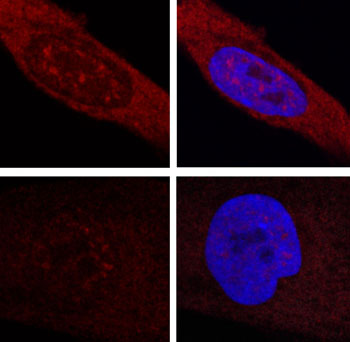Blocking Mutant RNA Cures Huntington's Disease in Mouse Model
By Gerald M. Slutzky, PhD
Posted on 23 Nov 2016
Researchers seeking ways to treat Huntington's disease have suggested going after the messenger RNA that mediates between the mutant gene that causes the disease and the toxic protein that causes the neurological damage that characterizes it.Posted on 23 Nov 2016
Huntington’s disease (HD) is caused by a dominant gene that encodes huntingtin protein. The 5' end of the HD gene has a sequence of three DNA bases, cytosine-adenine-guanine (CAG), coding for the amino acid glutamine, which is repeated multiple times. Normal persons have a CAG repeat count of between seven and 35 repeats, while the mutated form of the gene has anywhere from 36 to 180 repeats. The mutant form of huntingtin is broken down by the cell into toxic peptides, which contribute to the pathology of the syndrome. Recent evidence has also linked HD pathogenesis to stable hairpin RNAs formed by the mutant HTT expansion.

Image: Photomicrographs of fibroblasts from patients with Huntington\'s disease marked with fluorescence. Top row: the cells have accumulated mutant RNA. Bottom row: the cells no longer show blocked RNA accumulations (Photo courtesy of the Center for Genomic Regulation).
Investigators at the Center for Genomic Regulation (Barcelona, Spain) have presented evidence showing that a synthetic locked nucleic acid–modified antisense oligonucleotide complementary to the CAG repeat segment of the gene (LNA-CTG) preferentially bound to mutant HTT without affecting HTT mRNA or protein levels. They reported in the October 10, 2016, online edition of the Journal of Clinical Investigation that LNA-CTGs promoted neuroprotection by blocking the detrimental activity of CAG repeats within HTT mRNA.
LNA-CTGs produced rapid and sustained improvement of motor deficits in an R6/2 mouse HD model that was paralleled by persistent binding of LNA-CTG to the expanded HTT exon 1 transgene. Motor improvement was accompanied by a pronounced recovery in the levels of several neuronal markers that were severely impaired in R6/2 mice. Furthermore, in R6/2 mice, LNA-CTG blocked several pathogenic mechanisms caused by expanded CAG RNA, including small RNA toxicity.
"What we have observed in our study is that the mutated fragment acting as a conveyor-the so-called messenger RNA-is key in the pathogenesis," said senior author Dr. Eulàlia Martí, acting group leader of the genes and disease laboratory at the Center for Genomic Regulation. "The research on this disease being done by most groups around the world seeking new therapeutic strategies focuses on trying to prevent expression of the mutated protein. Our work suggests that blocking the activity of messenger RNA (the "conveyor"), would be enough to revert the alterations associated with Huntington's disease. We hope this will contribute to improving the strategies in place to find a cure."
Related Links:
Center for Genomic Regulation










 (3) (1).png)


